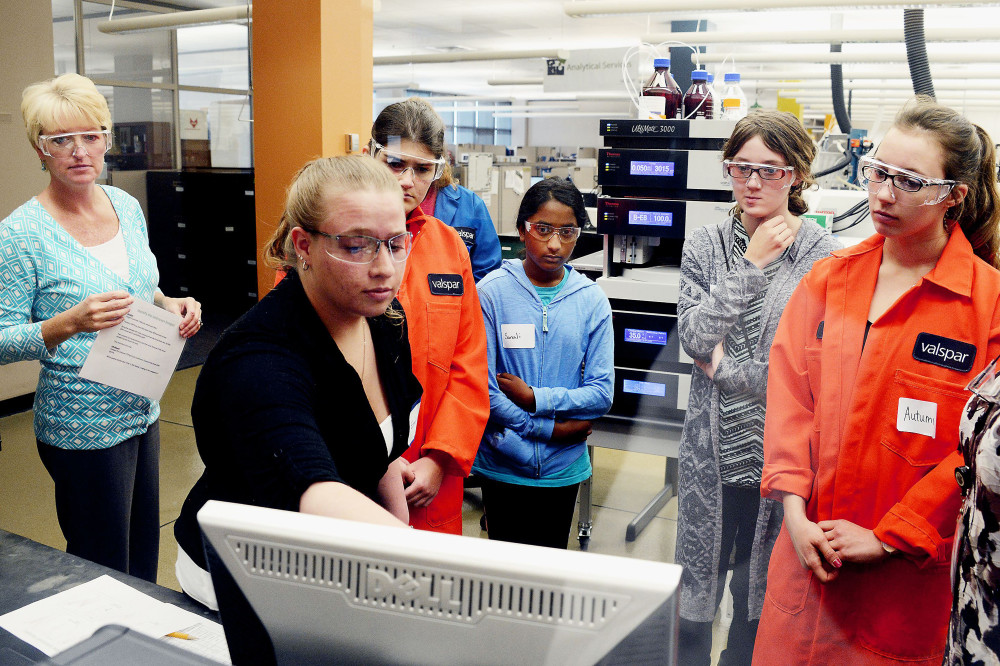By Damien Willis
Las Cruces Sun-News, N.M.
WWR Article Summary (tl;dr) A great look at how several programs in New Mexico are empowering women in tech. As 13 year old Bethany Gruenig puts it “Robotics isn’t just for guys,”…”We need to become engineers, so there are more women engineers. Some of the best ideas — not discriminating against guys, or anything — but some of the best ideas have come from women engineers.”
LAS CRUCES
As students of all ages from across New Mexico competed Saturday in a statewide robotics competition on the campus of New Mexico State University, an organization devoted to encouraging girls to seek out careers in science and engineering had its monthly board meeting just three blocks away.
“I think girls should definitely be encouraged to participate in robotics, and learning about technology,” said Bethany Gruenig, a 13-year-old eighth grader from Rio Rancho. Bethany was competing on the R4 Robotics Team, a team made up of home-schooled students from Rio Rancho.
More than 40 teams from around the state participated in the New Mexico VEX Robotics State Championship at NMSU’s James B. Delamater Activity Center. Teams traveled from as far away as Santa Fe and Carlsbad to compete at two levels–the VEX IQ competition, for elementary and middle school students, and the VRC competition for high school students.
“Robotics isn’t just for guys,” Bethany said. “We need to become engineers, so there are more women engineers. Some of the best ideas — not discriminating against guys, or anything — but some of the best ideas have come from women engineers.”
A social activity
“I really enjoy learning new things, and the teamwork that’s involved,” said Bethany’s teammate, 13-year-old Reva Keintz of Rio Rancho. “You learn so much about teamwork, and how to work together to solve problems as a team. And it’s also fun to just be with your friends.”
Rebecca Galves, president of the New Mexico Network for Women in Science and Engineering, said that engaging young girls in science must be done when they’re young, and that there is a strong social component.
“What we’re learning is that young women fall out of favor with STEM (science, technology, engineering and math fields) when they reach high school,” Galves told the Sun-News after her organization’s board meeting adjourned. About a dozen board members met Saturday in a classroom in NMSU’s Science Hall — some participating remotely by video conference.
“What we have discovered is that, if you can create that social network — even outside of a student’s school or community — in which young women have friends that can come and participate in the STEM events, they will stick with it,” Galves said.
buy kamagra oral jelly online www.mydentalplace.com/wp-content/themes/twentytwelve/inc/en/kamagra-oral-jelly.html no prescription
“They will maintain it through high school, and will, more often than not, major in a STEM field in college.”
A narrowing disparity
Because STEM fields cover a wide swath of the academic spectrum, the gender gap varies widely between disciplines.
“In some fields, like biology, there are more women than men,” said Galves, who is also a program specialist in NMSU’s Computer Science department. “Fields like computer science, however, are only about 11 to 14 percent women. Here at NMSU, we have the Young Women in Computing program, which addresses that exact issue.”
The YWIC program has made a notable difference at NMSU. When the program was launched in 2006, female enrollment in the university’s Computer Science program was at about eight percent. A decade later, it’s around 22 percent.
“It’s still a really big issue,” Galves said. “We have summer camps that specifically target girls, to try to get them interested and engaged. We’ve had about 400 young women from Las Cruces go through that program, and 63 percent of them are now majoring in STEM.”
A broader application
“I think you’re going to see more women in engineering and technology, in general,” said Patricia Sullivan, NMSU’s associate dean of the College of Engineering, as she watched the robotics competition. “A shift is taking place across the country — in terms of environmental sciences, healthcare, and technology generally becoming more socially-conscious. Women tend to gravitate to things that have a social application.”
As technology empowers young people to get more involved in the world around them, Sullivan said she suspects the gender gap in technology will continue to shrink.
“In the past, it was a very hands-on application,” Sullivan said. “Now, technology is being used to address problems that are broader in scope. Technology is everywhere. Now, there’s an app for reporting littering. You can create prostheses to impact healthcare. You can use technology, from a remote location, to improve water quality elsewhere.”
At Saturday’s competition, girls made up about half of the members of participating teams, according to Tracy O’Neil, a program manager for NMSU’s College of Engineering, who helped organize the VEX Robotics event.
“It’s important to us to try to get girls involved in engineering, especially at these early stages,” O’Neil said. “When girls learn that they can get into engineering early on, they’re more likely to pursue engineering degrees when they get to college. Competitions like this are a great way to get them engaged at a young age.”
















































































































































































































































































































































































